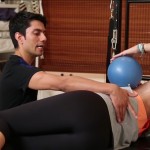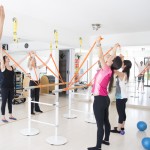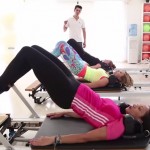With its gentle, whole-body approach to recovery, Pilates is a good choice for clients with back pain.
A vast majority of the active population experience back pain at one time or another. The discomfort can range from mild to severe or debilitating. Men and women are equally affected, and the pain can be caused by sedentary living, aging or overuse (e.g., repetitive motion during a sport).
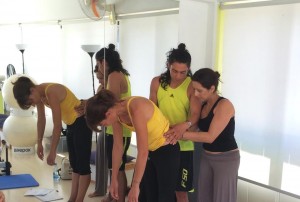
Often, people are told to strengthen their abdominal muscles to fix a back problem. However, traditional crunches usually strengthen only the outer layers of the abdominal musculature, specifically the rectus abdominis, while bypassing the deep support structures. This can place the lumbar spine in too much flexion and may even exacerbate back pain, depending on what the original physical problem was. If the deeper stabilizers of the lumbar spine —the transversus abdominis and multifidus— are not properly trained, they cannot alleviate the pain or stabilize the spine.
Current research suggests it is important to facilitate stability of the lumbar spine by strengthening these deep stabilizers (Richardson, Hodges & Hides 2004). It is also important to restore the neutral alignment of the joints that make up the lumbopelvic region. Pain occurs when muscles become imbalanced or dysfunctional, thereby losing their effectiveness as stabilizers. When this occurs, the core muscles cannot support the vertebrae in the spine during everyday movements. Other, more superficial muscles, like the rectus abdominis and external obliques, must take over and try to do their work. Since these large muscles cannot stabilize the small, independent joints of the spine, this often results in compressive forces on the intervertebral disks.
Pilates, with its focus on body awareness and proper alignment, can be beneficial for people recovering from low-back injuries or experiencing low-back pain. For Pilates practitioners, instructors and clients, the method has become an invaluable aid in preventing and managing low-back issues.
How Pilates Can Help
In his time, many considered Joseph Pilates a master of rehabilitation. His method temporarily became known as an elite form of exercise for the rich, famous or highly skilled, but the medical and rehabilitation communities have now embraced it. Pilates is a gentle, restorative exercise regime that suits most people in the process of recovering from injury and rebuilding their bodies. The foundational approach focused on core strength, precision and control of movement. Combined with current exercise science, this approach is a recipe for success, for a number of reasons.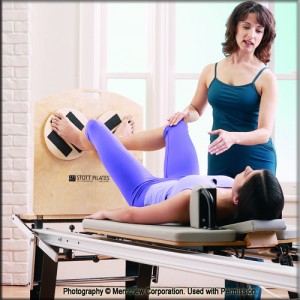
Pilates Develops Body Awareness.
Clients need this awareness in order to recruit and strengthen the deep stabilizing muscles. Well-trained instructors teach clients to recognize when these muscles are activated and how to control the muscular contractions so as to provide support while maintaining the integrity of the muscular and skeletal structures involved.
As suggested by Motor Learning Theory, most beginning clients are unaware of whether they are using their deep stabilizers or not (Richardson, Hodges & Hides 2004). This leaves them vulnerable to pain. With proper Pilates cuing and instruction, clients learn first that they are not using their stabilizers and then how to recruit them. Finally, they progress to integrating the stabilizers and using them unconsciously during daily activities. This helps in preventing further injury and rehabilitating the spine.
Pilates Promotes Effective Breathing Patterns.
Effective breathing patterns alleviate stress, which can be a major source of back pain. Conscious breathing provides inner focus, allowing clients to become more aware of their bodies and enabling recruitment of the deep stabilizing muscles.
Pilates Emphasizes Quality of Movement.
Clients are required to perform exercises with precision through each execution. Instead of doing many repetitions of the same movement mindlessly, with little concern for form or accuracy, they do fewer repetitions correctly and with care. This is more beneficial than doing the same moves over and over with a faulty muscular firing pattern. A variety of exercises that recruit the same or similar groups of muscles are performed in sequence, allowing both client and instructor to maintain focus.
Pilates Develops Core Strength.
Practitioners learn to engage the deep pelvic floor, which in turn works with the transversus abdominis and affects the positioning of other structures in the lumbopelvic region, providing support for the lower back.
Pilates Addresses Joint Functionality.
In many cases, back pain results from either hyper- or hypo-mobility of various joints that affect the back and pelvic girdle. For example, if the thoracic spine or hip joints do not move in a biomechanically efficient way, the more mobile lumbar spine will compensate for the loss of motion. Pilates addresses such issues by looking at the functionality of individual joints and how they can work together with adjacent joints to provide natural, pain-free movement patterns within normal ranges of motion.
Pilates Uses Props and Equipment to Aid Progress.
Props and larger equipment provide proprioceptive feedback, encouraging proper form and ensuring optimal muscular recruitment, joint stabilization and range of motion. Modifications of standard exercises lead to progressions that take injured clients from the acute stages of injury through to day-to-day activity and beyond.

